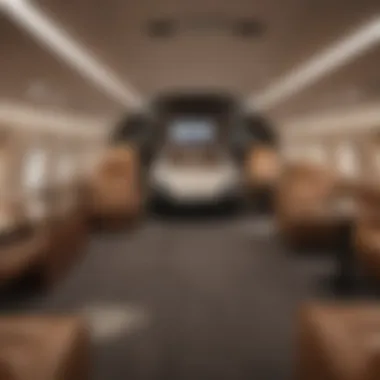Comprehensive Guide to Private Jet Charter Costs


Intro
Chartering a private jet can make the dream of flying on your own terms a reality. It embodies luxury and flexibility, definitely a far cry from the cramped flying conditions most people associate with commercial airlines. Yet, the reality of chartering a jet often comes with layers of complexity regarding costs, leaving many potential flyers scratching their heads over the true expense.
Overview of the Topic
Chartering a private jet isn’t just about paying for the flight; this option opens up a Pandora’s box of costs that require careful consideration. Understanding these expenditures is crucial for anyone wishing to dip their toes into this sphere.
It’s essential to grasp the definition of a private jet charter. This service allows individuals to hire an entire aircraft for a trip, unlike purchasing a ticket for a seat on a commercial flight. The importance of demystifying the costs associated with this choice cannot be overstated, as there are more factors at play than the base fare.
Key Benefits of Chartering a Private Jet:
- Convenience: Direct routes to locations often not serviced by commercial airlines.
- Time-saving: No long lines at security or waiting for connecting flights.
- Comfort: Personal space designed for relaxation and productivity.
However, these perks come at a price, and being aware of those costs allows travelers to make informed decisions.
Breaking Down the Costs
Getting into the details, it’s not uncommon for the initial fare to be only the tip of the iceberg. Additional factors that can influence pricing include the season you’re traveling in, the type of jet chosen, and even the length and complexity of your trip. Here's a simple rundown of costs to expect:
- Base Fare: The flat cost of the flight based on distance and aircraft.
- Fuel Surcharges: Depending on fluctuating fuel prices, this can significantly inflate the cost.
- Landing and Parking Fees: Aircraft must pay to land at many airports.
- Crew Costs: This includes the pilots and attendants who will be working on your flight.
- Catering and Amenities: If you wish to have gourmet meals or other luxurious extras, this can add up fast.
Understanding these costs creates a clearer picture.
Practical Tips for Planning a Charter
To navigate the often muddy waters of private jet chartering, consider these practical tips:
- Plan Ahead: Jet charter costs can soar last minute.
- Compare Different Charter Companies: Rates can vary widely, so shop around.
- Be Flexible: Changing flight times or dates can offer significant savings.
Implementing strategic approaches and leveraging technology can enhance the experience. For instance, online platforms like JetSmarter or PrivateFly can provide instant quotes and easy comparisons.
"Knowledge is power, especially when it comes to making discerned financial choices."
Understanding the requirements and options available can lead to better signatures on the dotted line of your travel plans.
Prelude to Private Jet Chartering
Chartering a private jet may seem like a luxury reserved for the elite, but it has become increasingly accessible for various travelers needing efficiency and convenience. In this section, we lay the groundwork for understanding private jet chartering. The ability to bypass long check-in lines and crowded terminals is just one of the many advantages that come with this mode of travel. It's not merely about flying; it's about the experience, flexibility, and time saved.
When considering chartering a private jet, one must understand not only what it entails but also its potential impact on travel plans and budgets. This understanding is crucial in making informed decisions. For instance, lessons learned from choosing the right aircraft type to understanding the additional fees that can surface are vital for a smooth journey.
Defining Private Jet Charter
A private jet charter is when individuals or groups hire an aircraft for their exclusive use, often for a specified trip. Unlike commercial flights, where seats are booked on a set schedule with multiple passengers, a charter offers entire control over the travel itinerary. To charter a jet, you typically coordinate with a broker or charter service, deciding on the type of aircraft, itinerary, and additional services as needed.
This approach grants travelers greater autonomy—be it flying directly to an out-of-the-way destination or altering routes on the fly. But it doesn't come without its intricacies. For example, knowing the different types of charters, whether on-demand or block hours, can profoundly affect pricing structures and availability.
Why Charter a Private Jet?
The question isn't just why one would charter a private jet, but rather, why not? The reasons vary from the pragmatic to the indulgent. Many people are drawn to private jet charters for the time saved—it can cut hours off travel plans, especially when traveling to multiple destinations or remote locations that lack commercial service. Additionally, for business professionals, the ability to work during flight hours translates into productive time, eliminating lost hours typically spent waiting at airports.
There are also significant comfort and privacy benefits. A private jet can be tailored to make the journey as enjoyable as possible, depending on individual preferences and needs. Passengers can enjoy customized catering, lounge areas, and the chance to avoid the hustle and bustle of crowded terminals.
"Chartering a private jet is about maximizing your time and comfort, precisely how you want it."
The exclusivity of a private jet might appeal to anyone looking to make an impression, whether for business negotiations or personal endeavors. In essence, chartering offers a blend of speed, comfort, and sophistication that simply can’t be matched.
As we delve deeper into the various factors contributing to the costs of chartering a private jet, keep these defining elements and motivations in mind. They form a foundation for understanding the financial implications and strategic decisions involved in private aviation.
Factors Affecting Charter Costs
When looking into chartering a private jet, it’s key to grasp the multifaceted world of costs that can impact your bottom line. Various elements come into play, from the choice of aircraft to flight distance and the time you decide to book your trip. Understanding these factors can help you navigate through potential expenses and set realistic expectations for your private flying experience.


Type of Aircraft
The type of aircraft you choose can dramatically influence the overall cost of chartering a private jet. Different aircraft types cater to different needs, and each carries its unique price tag.
Light Jets
Light jets, such as the Citation Mustang, are perfect for short-haul flights and can reach smaller airports where larger jets can’t land. Their lower operating costs make them an attractive choice for those looking to save money on shorter trips. A standout characteristic of these jets is their efficiency; they require less fuel, which can significantly cut down on overall expenses. However, while the lower costs are appealing, the limited space and range can be a disadvantage for passengers who prioritize comfort or need to travel longer distances.
Midsize Jets
Midsize jets like the Hawker 800 are often regarded as a sweet spot for many charters. Offering a spacious cabin and a longer range compared to light jets, they are suitable for both short and medium-haul flights. Their notable characteristic is the balance they strike between comfort and cost – enough room for a few passengers and luggage without breaking the bank. That said, one might find that if you book during peak times, the prices could soar, making it slightly more costly than anticipated.
Heavy Jets
Heavy jets, for instance, the Gulfstream G650, are the heavyweights of private aviation, built for long-haul flights and ultimate luxury. They offer ample space for larger groups and longer ranges, ideal for intercontinental travel. While the luxury is undeniable, so is the price. Heavy jets come with high operational costs, which can make them less appealing for those on a budget, but they deliver an exceptional flying experience.
Executive Airliners
Executive airliners, such as the Embraer ERJ-135, are designed with comfort in mind, akin to flying in a private lounge. They are perfect for business travelers needing to carry a significant number of passengers while still requiring all the amenities. Their size and features command a higher price, making them a preferred choice for companies or groups willing to invest in a luxurious travel experience. However, the cost to charter these larger jets might not align with every trip.
Flight Distance
When it comes to flight distance, a crucial aspect lies in distinguishing between short-haul and long-haul travel. Understanding this can provide insight into how costs are determined.
Short Haul vs. Long Haul
The distinction between short haul and long haul isn’t just about miles; it affects the overall pricing structure. Short haul flights, typically lasting under three hours, appeal to those needing quick access to nearby locations, often at reduced rates. On the contrary, long-haul flights incur additional expenses for fuel, landing fees, and crew overtime. Costs can balloon swiftly when you go beyond that four-hour mark, requiring travelers to budget accordingly.
Operational Costs Based on Distance
Another crucial point consists of operational costs based on distance. Some aircraft use more fuel than others, and this can vary significantly depending upon how far you’re flying. When planning a trip, always consider the operational costs tied to the range of your journey. Heavy aircraft will inflate these figures with their high fuel consumption, while more economical jets will help keep those costs minimal. Pay attention to these details to ensure you’re not caught off guard.
Urgency and Flexibility
Urgency in booking your jet itinerary can also impact costs. Last-minute arrangements often come with a premium price; however, having flexible travel dates can work in your favor.
Last-Minute Bookings
Last-minute bookings can be a double-edged sword – there are times when you might score a deal, especially if the aircraft needs to fill up empty seats. However, it’s more common to see higher rates due to the unpredictable nature of demand and supply. So, if spontaneous trips are your style, be prepared for potentially steep costs in some situations.
Flexible Travel Dates
Having flexible travel dates can save you a penny. Airlines and charter companies sometimes have better deals and availability midweek or during off-peak seasons. This flexibility can lead to notable savings, enhancing the charm of private jet travel without leaving a hole in your wallet.
Seasonality and Demand
The time of year dictates cost in a significant way. Charter prices rise and fall with demand, making it essential for potential travelers to keep a close eye on seasonal fluctuations.
Peak Travel Seasons
During peak seasons, such as holidays or big events, prices are often at their peak. Many folks are looking to charter jets, resulting in higher rates due to increased demand. If you plan to travel during these times, it’s wise to book well in advance.
Special Events Impacting Availability
Special events, like major sporting tournaments or conventions, can have an overwhelming effect on jet availability and pricing. With limited aircraft in a specific area during these events, travelers might face steep rates or a lack of options altogether. Always check local calendars and plan ahead to avoid unnecessary budget strains due to unexpected situations.
Breaking Down the Costs
Having knowledge of what to expect ensures that travelers can budget effectively. It also serves to highlight which aspects offer flexibility and potential savings. Thus, understanding these costs becomes an essential exercise.
The Base Fare
The base fare serves as the foundation of the total cost when chartering a private jet. This amount typically covers the essential expenses associated with dispatching the aircraft and is calculated based on the charter service provider’s pricing structure.


However, the base fare can vary enormously depending on the type of jet selected. For example, a lavish Gulfstream G550 comes with a heftier price tag, while smaller jets like the Citation Mustang may be more budget-friendly. Understanding these base fares helps prospective buyers align their expectations with reality.
Fuel Surcharges
Fuel surcharges are added costs that reflect fluctuations in fuel prices. Given the volatility of the oil market, these surcharges can significantly impact the total fare.
Jet fuel can be pricey, and when oil prices spike, chartering firms often transfer some of these costs onto their clients. It’s wise to inquire about current fuel rates, as this can result in sizeable differences in quoted prices, especially for longer flights.
Landing Fees
Landing fees are another factor that can surprise many travelers. These fees vary widely by airport and are charged for the use of runways and other airport facilities. Larger airports generally impose heftier landing fees, while smaller regional airports may have more favorable rates.
Consider this: landing at a glitzy airport like Los Angeles International might cost significantly more than at a quaint regional airport. Being aware of these costs in advance can help travelers choose routes that optimize not just flight time but also overall expenses.
Airport Taxes
Airport taxes are levied by governments on aircraft operations at their airports. These costs can be intricate and vary considerably, often based on the destination country.
These taxes might seem minor when considered individually but can accumulate quickly, leading to a notable impact on your total expenditure. Knowing the taxes beforehand allows for better financial planning and helps in avoiding unintended surprises.
Crew Expenses
Crew expenses typically encompass not just salaries but also additional costs associated with the crew’s operational requirements. This includes accommodations, meals, and sometimes even their transportation. For longer flights, the necessity of a relief crew can also come into play.
These costs are essential components to consider because they may not be included in the initial quote. A total overview of your travel costs requires a thorough understanding of crew-related expenses as they add to the overall financial burden.
Additional Services and Amenities
When thinking about private jet charters, the ancillary services offered can dramatically enhance your journey, though they do come at a price. Understanding how to budget for these extras ensures an enriching flying experience.
Ground Transportation
Ground transportation is pivotal in concluding your travel experience seamlessly. From airport pick-ups to drop-offs, having reliable ground transport is essential for maximizing the value of your chartered experience.
With options ranging from luxury SUV rentals to chauffeur-driven sedans, it adds another layer of comfort and exclusivity. However, assessing the costs of these services beforehand is critical, as they can add up significantly based on distance and vehicle type.
Catering
Catering is often touted as a luxury of private flying, where you can enjoy gourmet meals prepared especially for you while soaring thousands of feet above the ground. This service can range from basic snacks to extravagant multi-course meals developed by top chefs.
The appeal lies in the flexibility of menu choices, which can cater to dietary restrictions or preferences. Nevertheless, it’s important to grasp that these lavish options can contribute substantially to the overall bill.
Special Requests
Special requests cover unique needs that travelers might have during their journey. These can range from specific onboard entertainment choices to arranging special items or decor in the cabin.
The beauty of arranging such requests lies in the tailored experience they provide, making your flight memorable. However, one must be aware that many charter companies may charge extra for such arrangements. Therefore, being clear about what you want and what you expect to pay for it is vital.
Comparing Costs with Other Air Travel Options
When it comes to air travel, chartering a private jet often appears to be a cut above the rest. However, understanding how its costs stack up against other travel options is crucial. Comparing costs with commercial airlines, fractional ownership, and jet card programs helps passengers comprehend what they’re truly paying for, allowing for informed decisions tailored to their specific needs.
Commercial Flights
Price Comparison
Price comparison between private jets and commercial flights doesn’t tell the whole story. On one hand, commercial flights provide relatively inexpensive tickets, particularly when booked in advance or during sales. It's not unusual to find a round-trip fare for a few hundred dollars on larger airlines, especially during off-peak seasons.
However, while looking at base fares, it’s essential to consider the hidden costs involved with commercial flights, such as luggage fees and seat selection charges. Additionally, there’s often the hassle of long security lines, cramped spaces, and lack of flexibility in travel times. Thus, comparing prices just based on the base ticket may not reflect the total travel experience.
Another factor is that commercial flights have their limitations when it comes to destinations. They might not service smaller airports, requiring longer drives to the desired final destination, which can impact overall travel time, making that cheaper ticket a less appealing option.
Convenience Factors


The convenience of commercial flights is often overrated. While major airlines may have numerous flights daily, the reality is that they follow strict schedules. Passengers need to arrive ahead of time, go through security, and often face layovers. One might feel like they’re jumping through hoops just to catch their flight.
With commercial travel, passengers are bound by the airline's schedule, making it less convenient for last-minute trips. In contrast, private jets offer flexibility, allowing travelers to create their own schedules and avoid lengthy wait times. This unique feature can be a game changer, especially for those whose plans change frequently. Amenities like a more personalized service and greater comfort make charter flights a more attractive option despite the higher costs.
Fractional Ownership
Cost Structure
Fractional ownership allows individuals to buy a share in a jet, spreading the costs among multiple owners. This model lowers the financial barrier compared to outright ownership of a private jet. However, understanding the cost structure requires careful scrutiny. While up-front fees may seem friendly, ongoing maintenance, operational costs, and potential management fees add to the total financial investment.
The key characteristic here is that fractional ownership is designed to provide the benefits of private travel without the full commitment. It’s particularly appealing for frequent travelers who value having access to a private jet but don’t intend to fly exclusively.
However, owners must also be aware of the limitations tied to the scheduling rights and potential fees for exceeding their assigned flight hours. This downside makes it essential for prospective buyers to evaluate how often they truly intend to fly.
Usage Limitations
While fractional ownership offers a more economical path to private aviation, it comes with notable usage limitations. The fractional share dictates how many hours the jet can be flown by an owner. This isn’t a flexible model; if you need to fly more than your allotted time, additional charges quickly stack up. This can lead some owners into unexpected financial waters.
This structure is appealing because it ties ownership to actual usage, promoting a more rational approach to spending. However, for those who value limitless travel or have unpredictable flight patterns, these limitations might make fractional ownership less enticing.
Jet Card Programs
Prepaid Models
Jet card programs operate on a prepaid model, often providing a straightforward solution for those who prefer simplicity in booking private flights. Customers purchase a specified number of flight hours, which can typically be used throughout a certain timeframe. This approach makes costs more manageable and predictable, allowing travelers to budget more effectively for their air travel.
The key advantage to prepaid models is the convenience they provide. Passengers can make reservations without worrying about fluctuating rates or additional fees. However, some programs may have restrictions or minimal booking windows that could cause headaches for spontaneous travelers.
Flexibility in Use
The flexibility provided by jet card programs can’t be overstated. Users benefit from being able to access multiple aircraft types depending on their needs, whether it’s a small jet for a short haul or a larger jet for a long flight. This adaptability allows customers to tailor their travel experience based on the trip demands, something that traditional commercial airlines cannot offer.
However, much like fractional ownership, jet cards come with expiration dates on prepaid flight hours and service limitations, which can lead to lost value if not utilized efficiently. This makes it crucial for purchasers to carefully assess their flight needs against the terms of their jet card program.
The bottom line is, comparing costs involving these options isn't just about dollars and cents. It's about convenience and how those additional costs fit into the travel lifestyle you desire.
Budgeting for Your Private Jet Charter
When it comes to chartering a private jet, budgeting is not just a formality; it’s a necessity. Understanding the costs associated with hiring a private jet helps in planning a trip responsibly while avoiding any financial surprises. Budgeting isn’t merely about setting a figure; it encompasses a lot of nuances that can influence the overall expenditure on private aviation.
Setting a Budget
Establishing a budget for your private jet charter requires a clear understanding of all the related costs involved. Rather than aiming for a round number, the approach should be detailed. A comprehensive budget considers not only the base charge of the aircraft but also various additional fees like fuel surcharges and landing costs.
- Base Cost: Start with the base charter rate which is influenced by the type of aircraft you select. Different jets, whether they be light jets like the Cessna Citation or heavy jets like the Bombardier Global Express, have varied pricing structures.
- Operational Factors: Distance plays a crucial role too. Longer flights often come with escalating costs due to higher fuel consumption and crew time. Are you thinking of a transcontinental trip or just a quick jaunt? The distance would likely dictate the base fare.
- Additional Expenses: Don’t overlook fees such as airport taxes and costs related to catering. These can sneak up on you, especially during peak seasons when demand drives prices up. A little research will go a long way here.
- Contingency Fund: It’s wise to include a little wiggle room in your budget for those unexpected costs that might pop up. After all, nobody likes being caught off guard.
Understanding Value vs. Cost
In the realm of private aviation, discerning between value and cost is paramount. It’s not just about what you pay but what you receive in return. The distinction between the two can have a substantial impact on your overall satisfaction with the chartering experience.
- Value: Consider the benefits that come with the offering. For example, if a charter service provides a level of luxury and comfort that makes your flight exceptionally enjoyable, then that added price tag may well be worth it.
- Cost: It’s easy to fall into the trap of merely comparing costs. But, if an option that seems cheaper lacks essential amenities or punctuality, it might actually cost you more in lost time or disruptions.
"The cheapest option isn’t always the best; a higher price can sometimes mean a smoother journey with top-notch service."
- Experience Factor: Evaluate what is included in the package. High-end catering, cabin crew service, and luxury ground transfers can elevate your travel experience, adding more value to what you are paying. Think about what matters most for your trip—whether it’s time, comfort, or service—and align that with your budget.
Mapping out a budget when chartering a private jet ensures you are not only prepared for expenses but can also appreciate and enjoy the value that comes with private air travel. Investing a bit of time in this process means fewer worries later on, turning the experience into a gratifying venture rather than an unexpected financial burden.
End
Finally, we've arrived at the part where we wrap everything together about the costs tied to chartering a private jet. Understanding the various facets of private jet chartering is vital for anyone contemplating this option. The journey doesn't start and stop at just the flashy aircraft and luxurious interiors; it's the underlying costs that can turn the experience sour if not properly accounted for.
Making Informed Decisions
To make wise choices, you must equip yourself with solid knowledge. It is important to have a thorough breakdown of costs, from base fares right down to landing fees. When you're in the know, you can identify potential hidden charges that might pop up, and you can tailor your travel experiences to fit your budget without compromising on comfort.
Additionally, consider factors like urgency and flight flexibility. Understanding this landscape empowers you to negotiate better terms and even capitalize on seasonal price fluctuations. In a nutshell, being informed is your best ally. You'll not only secure a flight but ensure it's the right fit for your time, needs, and wallet.
Future Trends in Private Aviation
The private aviation sector is like a chameleon, constantly adapting. Recently, there's been a noticeable shift towards sustainability, with many charter companies exploring eco-friendly options. The buzz about electric jets is gaining traction, hinting at a future where you can fly without leaving a hefty carbon footprint behind. Furthermore, improvements in technology are making booking processes smoother and more transparent.
It's also crucial to keep an eye on how travel habits are evolving post-pandemic. There’s a growing appetite for personalized experiences, meaning service providers may start to offer even more bespoke solutions. As we look to the future, the aviation industry will likely undergo many adjustments that could further influence costs, availability, and even client experience in private jets. So, staying updated on these trends might just save you a pretty penny when you embark on your next skyward adventure.



